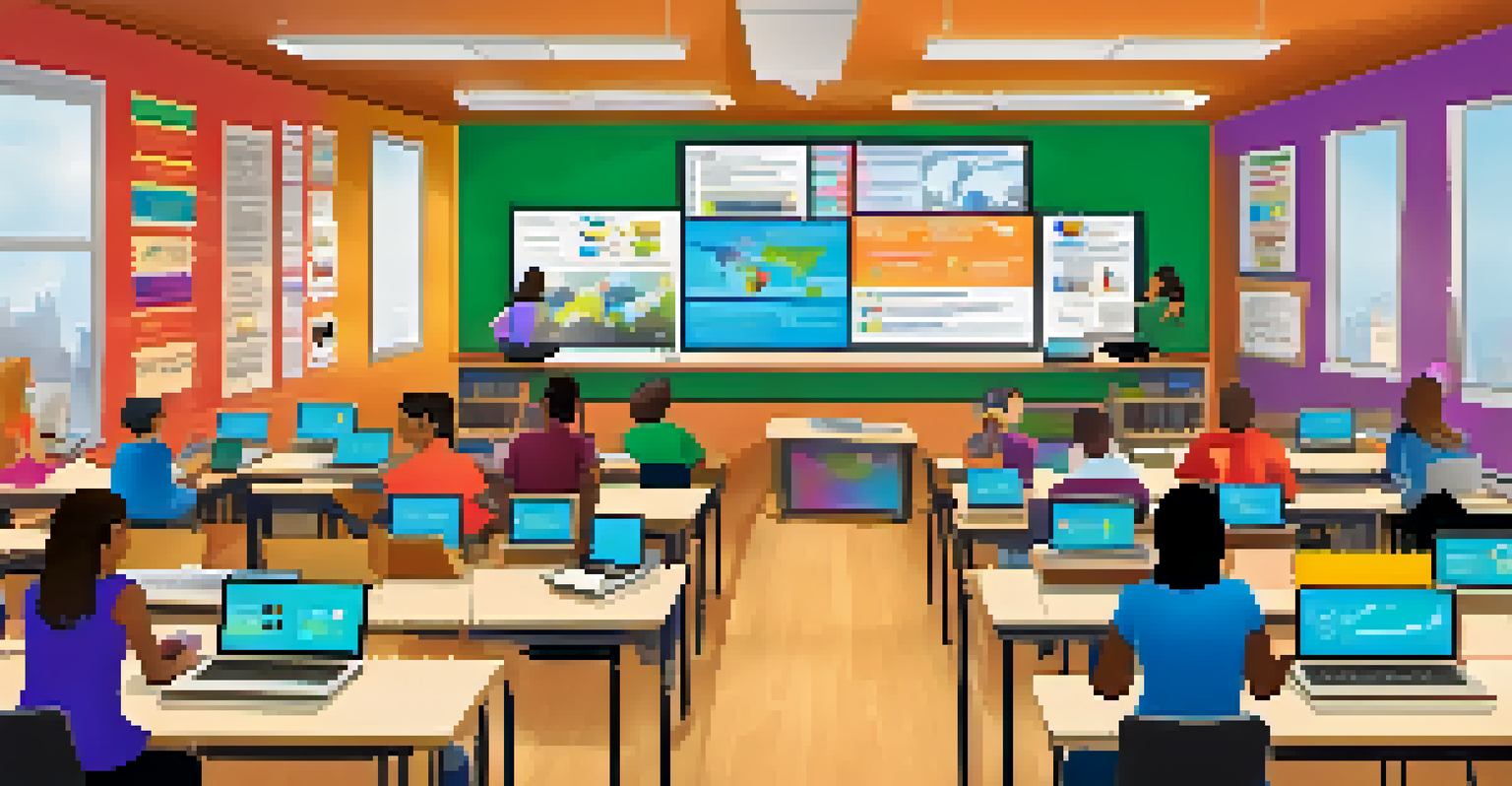The Role of Multimedia in Mobile Learning Experiences

Understanding Mobile Learning and Its Importance
Mobile learning, or m-learning, allows users to access educational content on-the-go using smartphones or tablets. This flexibility makes learning more accessible, especially for those with busy lifestyles. With the world increasingly relying on mobile devices, integrating learning into daily activities becomes vital.
Education is the most powerful weapon which you can use to change the world.
The importance of mobile learning lies in its ability to cater to diverse learning styles. Whether you're a visual learner who thrives on images or an auditory learner who prefers podcasts, mobile learning can offer tailored experiences. This personalization helps in improving retention and comprehension of information.
Moreover, mobile learning breaks geographical barriers, enabling learners from different locations to access the same resources. This inclusivity fosters a global learning community, where ideas and knowledge can be shared freely. Ultimately, mobile learning is not just about convenience; it's about creating opportunities for everyone.
The Role of Multimedia in Enhancing Engagement
Multimedia, which includes videos, audio, infographics, and interactive elements, plays a crucial role in making learning more engaging. For instance, a short video can explain complex concepts far more effectively than a textbook. This engagement is vital for keeping learners interested, especially in a mobile format where distractions are just a tap away.

Incorporating multimedia elements can cater to various learning preferences, making content more relatable and easier to digest. For example, combining text with visuals can create a richer context, allowing learners to grasp the material better. This multisensory approach can significantly enhance the overall learning experience.
Mobile Learning Enhances Accessibility
Mobile learning allows users to access educational content anytime, breaking geographical barriers and catering to diverse learning styles.
Additionally, multimedia can facilitate active learning, encouraging users to participate rather than passively consume information. Interactive quizzes or simulations prompt learners to apply what they've learned, reinforcing their understanding. By making learning an active process, multimedia helps learners retain information longer.
Creating Accessible Learning Materials with Multimedia
Accessibility is a critical aspect of mobile learning, and multimedia can help bridge gaps for diverse learners. Using captions in videos or providing transcripts for audio content ensures that everyone, including those with hearing impairments, can benefit from the material. This inclusivity not only enhances learning but also aligns with educational equity.
The only limit to our realization of tomorrow will be our doubts of today.
Moreover, multimedia can simplify complex ideas through visual representation. For instance, infographics can distill complicated data into easy-to-understand visuals, making them more approachable for learners. This clarity is especially important in mobile learning, where users may prefer quick, digestible content.
By prioritizing accessibility in multimedia content, educators can create a more equitable learning environment. This approach encourages learners from various backgrounds to engage with the material, fostering a sense of belonging. Ultimately, making learning accessible is not just a nice-to-have; it’s essential for effective education.
The Influence of Interactive Multimedia on Learning Retention
Interactive multimedia, such as gamified learning experiences, can significantly boost retention rates. When learners actively engage with content—like answering questions or solving problems—they are more likely to remember what they've learned. This active participation transforms passive learning into a memorable experience.
For example, a mobile app that incorporates quizzes and rewards can make learning feel like a game. This fun element encourages users to revisit content, reinforcing their knowledge over time. The combination of enjoyment and learning creates a powerful incentive for users to engage consistently.
Multimedia Boosts Engagement and Retention
Incorporating multimedia elements like videos and interactive quizzes makes learning more engaging and helps learners retain information better.
Additionally, interactive multimedia fosters a deeper understanding of concepts. When learners manipulate variables or make choices in a simulation, they gain insights that traditional methods may not provide. This hands-on approach can lead to a more profound comprehension of the subject matter, enhancing overall learning outcomes.
Multimedia’s Role in Collaborative Learning Environments
Collaboration is key in today’s learning landscape, and multimedia facilitates this by connecting learners. Tools like discussion forums, video calls, and shared resources create a sense of community, even in mobile learning. This interaction allows learners to share insights and learn from each other’s perspectives.
For instance, a group project conducted through a collaborative platform can leverage multimedia tools, allowing members to contribute in various ways. Whether through videos, presentations, or documents, each learner can showcase their strengths. This not only enhances the project but also promotes teamwork skills.
Moreover, collaborative multimedia projects can lead to higher engagement levels. When learners work together, they often feel more motivated to contribute and succeed. This communal effort enriches the learning experience, making it more dynamic and enjoyable.
Measuring the Effectiveness of Multimedia in Learning
To maximize the benefits of multimedia in mobile learning, it's essential to measure its effectiveness. Educators can use analytics to track engagement levels, comprehension rates, and user feedback. These insights can help refine content and strategies, ensuring that multimedia serves its intended purpose.
For example, if learners frequently abandon a video midway, it may indicate that the content isn’t engaging enough. By analyzing such data, educators can make informed adjustments, enhancing the overall learning experience. Continuous improvement is key to keeping learners motivated and successful.
Collaboration Enriches Learning Experiences
Multimedia facilitates collaborative learning environments, allowing learners to share insights and work together on projects, enhancing motivation and teamwork.
Additionally, surveys and assessments can gauge how well multimedia resonates with learners. Understanding their preferences allows for a more tailored approach, ensuring that content is both relevant and effective. Through these methods, educators can create a rich, adaptive learning environment.
The Future of Multimedia in Mobile Learning
As technology evolves, so does the potential for multimedia in mobile learning. Innovations like virtual reality (VR) and augmented reality (AR) are already making waves, offering immersive experiences that traditional methods can't match. These technologies can transport learners to different environments, making complex subjects come to life.
Moreover, advancements in artificial intelligence (AI) are paving the way for personalized learning journeys. AI can analyze a learner's progress and suggest tailored multimedia resources, creating a unique learning path. This customization ensures that every learner gets the support they need to thrive.

Looking ahead, the integration of multimedia in mobile learning will likely become even more seamless and intuitive. As devices become more powerful and user-friendly, the possibilities for enhancing learning experiences are limitless. Embracing these changes will be crucial for educators aiming to engage and inspire the next generation of learners.